June 4, 2024
Each January, the Transportation Research Board (TRB) holds its annual meeting in Washington, D.C. Researchers and practitioners from across the country gather to share the latest advances in transportation research and meet with their committees to have the conversations that drive the field forward.
Come the 2025 meeting, attendees will see some familiar Kittelson faces taking on new roles in various committees throughout the organization. Senior Principal Engineer Hermanus Steyn, Associate Engineer Pete Jenior, and Associate Planner Nick Foster are stepping into committee and leadership roles on TRB’s Design Section, Freeway Operations Committee, and Bicycle Transportation Committee, respectively. Below, we’ll take a closer look at each of their new roles and learn how they hope to contribute to their committees.
Celebrating these recent appointments gives us an opportunity to discuss what exactly these TRB committees do, and, by extension, why they matter. We also caught up with each appointee to get their perspective on where they see themselves fitting into their new committees, and how the changing responsibilities of the TRB committee is a way of understanding how TRB—and research in the industry—is itself changing.
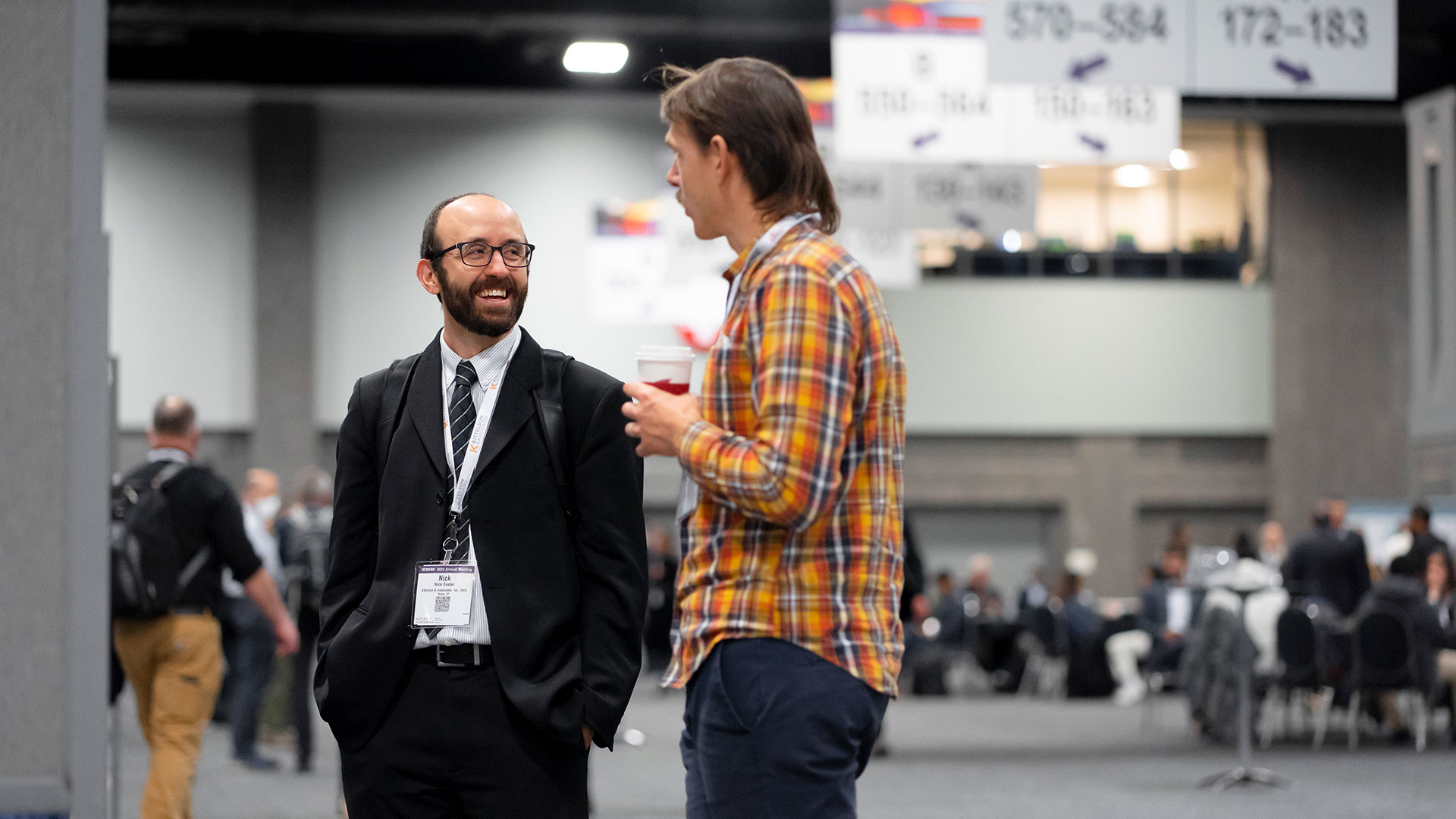
Nick Foster discusses a research poster at the 2023 TRB Annual Meeting.
Leaning on Peer Expertise to Create an Industry Brain Trust
Associate Planner Nick Foster serves as co-chair of the Bicycle Transportation Committee
Although TRB has its own full-time administrative staff, much of the essential work of its 175 research committees is done by over 8,000 volunteers. These volunteers are industry researchers and practitioners who, having perhaps attended a TRB conference or two, felt energized by their proximity to one of the industry’s thought epicenters and wanted to participate in it.
Nick Foster, the new co-chair of TRB’s Bicycle Transportation Committee, started out as one such volunteer in 2012. After becoming a friend of the committee and attending his second Annual Meeting, he offered to review research papers submitted to the committee. Reviewing research papers, along with hosting topical workshops and developing needs statements, are just some of the many tasks committee members take on to keep progressing the research in their committee topic area. It’s also a great first step for those looking to get more involved in committee work.
The Bicycle Transportation Committee is noteworthy among committees for its single-modality focus. Whereas most committees organize themselves around a certain technical topic (e.g., “Performance Effects of Geometric Design”), the Bicycle Transportation Committee is one of a few committees dedicated to research on a single modality. At first this translated to a proportional workload as there was not much research covering bicycling. Over the years, however, as the industry has increasingly embraced multimodalism and active transportation, the committee’s profile rose exponentially within TRB. Now the committee fields and reviews more than a hundred research papers on bicycle (and increasingly e-scooter) transportation each year and is one of the most active committees in terms of paper review requests.
The efforts of these volunteers are what make committees so vital to industry progress: collectively, TRB committees serve as barometers and intellectual trusts. Shifts in popularity of some committees can reflect larger tectonic movements of trends throughout the profession or a sudden compensation for a long-neglected topic area. Within a subject area, committees sort through various research inquiries and approaches and help sculpt the intellectual direction researchers move in. Committees play a central organizing role in advancing industry research, identifying the industry’s most pressing subjects and acting as a knowledge repository and sculptor for them.
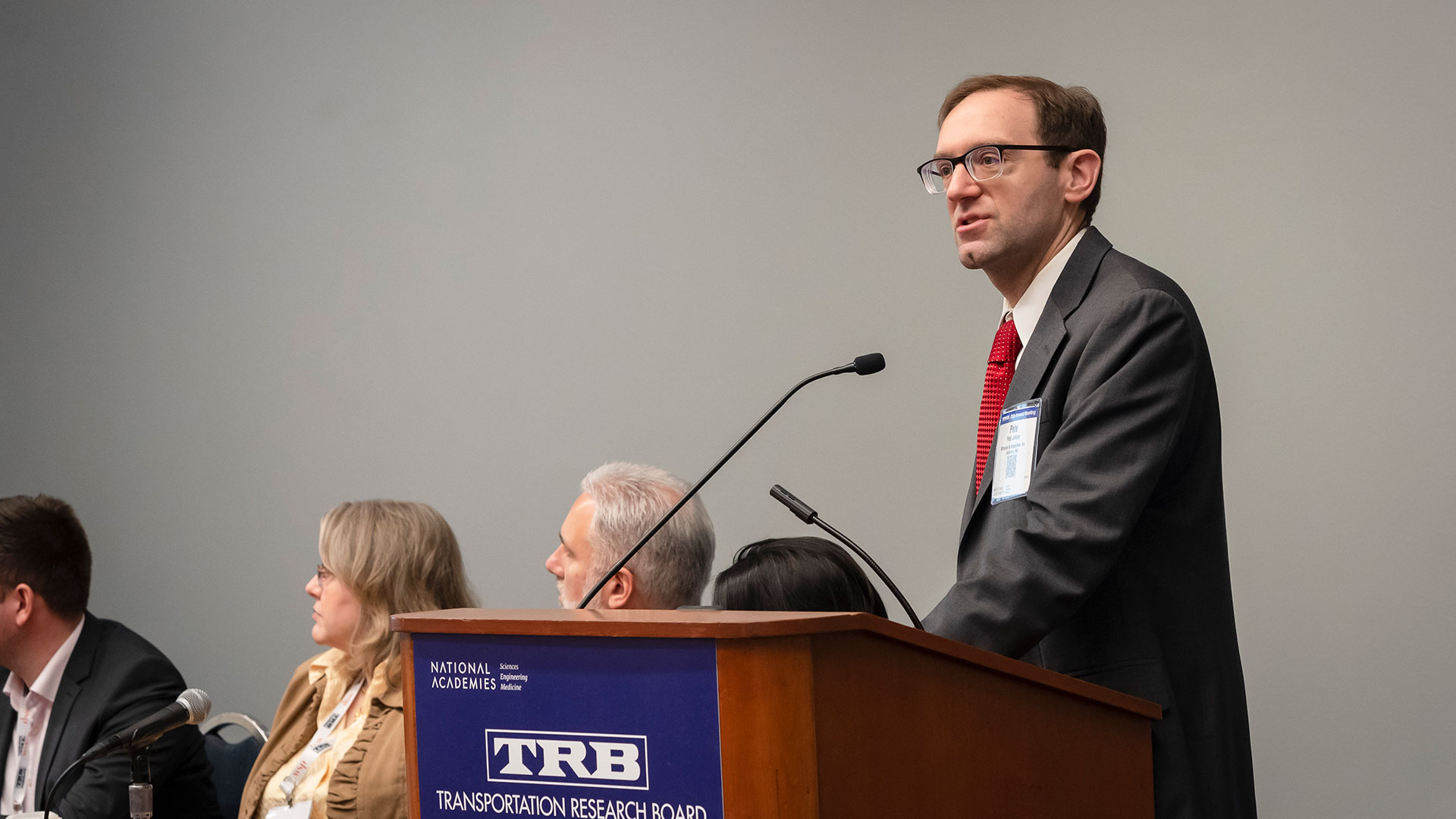
Pete Jenior presents at the 2024 TRB Annual Meeting.
A Seat at the Table: Shaping National Practice
Associate Engineer Pete Jenior serves on TRB’s Standing Committee on Freeway Operations
A member of the Performance Effects of Geometric Design Committee since 2011, Pete Jenior decided that this year was time for a change. Turnover is baked into the structure of TRB committees to ensure an intellectual freshness and variation of perspective, with limits on how long any member can remain on a committee. For the same reason, it’s generally frowned upon for a committee to have several sitting members from the same organization. In Pete’s case, several sitting members (including Pete) of the Performance Effects of Geometric Design Committee hailed from Kittelson. For the sake of continued innovation, it was time for Pete to leave.
Nevertheless, leaving TRB committee work altogether was never an option for Pete. Instead, he offered to volunteer on another committee, TRB’s Standing Committee on Freeway Operations, because it drew upon some of his current project work. If turnover ushered Pete out of his first committee, it welcomed him into this second: several vacancies on the Freeway Ops committee existed, and so he got a spot on the committee almost immediately.
Pete is a co-lead on tracking research needs statements for the Performance Effects of Geometrics Committee and looks forward to supporting the research needs statement work of the Freeway Operations Committee. This work helps keep the research ball rolling between annual meetings and prevents the enthusiasm over a research need from fading. Tracking research needs also helps to eliminate redundancies between generated research statements and research that may be already ongoing. It’s one more task committee volunteers take on to keep the industry’s research on track and internally coherent.
Why, when Pete’s tenure on the Performance Effects of Geometrics Committee came to an end, was he so eager to get right back into committee work? Why not take a break, or lighten his load by relinquishing TRB commitments entirely? Leaving TRB committee work never occurred to Pete because, after spending many years on them, he’s come to appreciate the way members can act as interlocuters between a national, often academic discussion and local clients with tangible needs and practical constraints.
Committee members can take the cutting-edge knowledge they’re exposed to in their committee work back to state and local transportation agencies, who may benefit from innovation but who may not have the resources or the time to engage with committees directly. When viewed this way, committees don’t purely carry an academic function; having a seat on a committee means having access to breakthroughs that can directly impact how roadways function in our communities.
Breaking Down Industry Silos
Hermanus Steyn serves as the Chair of TRB’s Design Section
Planning and designing projects the transportation industry should address these through the three-legged stool: Safety, Operations, and Design. Within TRB there is a Design Section that is overseen by a section chair, who is tasked with governing their constituent committees with a balance of direction and flexibility. While a section’s committees need to be able to be independent autonomously, the section chair encourages a reasonable degree of alignment and coordination between them.
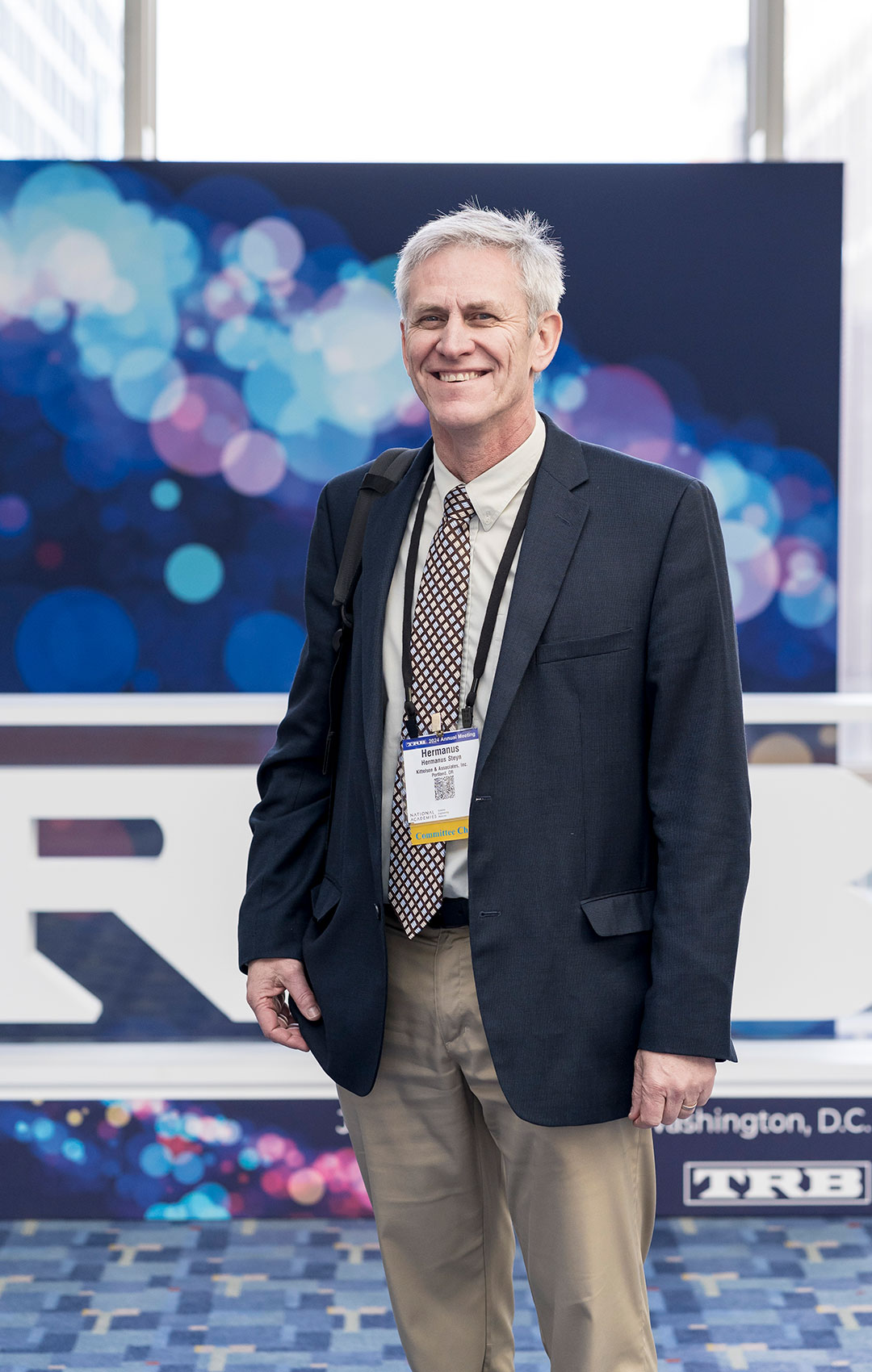 Senior Principal Engineer Hermanus Steyn (pictured right), who recently took over as the Chair of TRB’s Design Section, wants to strike this balance while also going further. Prior to this appointment, Hermanus chaired the Performance of Geometric Design Committee, where he noticed that, although the committee collaborated with other committees within the Design Section, it rarely interacted with any committee in the Operations or Safety sections.
Senior Principal Engineer Hermanus Steyn (pictured right), who recently took over as the Chair of TRB’s Design Section, wants to strike this balance while also going further. Prior to this appointment, Hermanus chaired the Performance of Geometric Design Committee, where he noticed that, although the committee collaborated with other committees within the Design Section, it rarely interacted with any committee in the Operations or Safety sections.
Now, as the chair of all Design section committees, Hermanus sees the appointment as an opportunity to break down the communication barriers between sections and groups to the betterment of TRB’s research practice.
Hermanus’s desire to break down research siloes complements wider, structural changes made to TRB’s research committees. TRB began consolidating like committees to simplify their hierarchy and keep like-minded researchers in touch with one another. (For instance, Hermanus’s previous Geometric Design committee in the Design Section was merged with another committee in the Operations Section—the Operational Effects of Geometrics Committee—to create a stronger, more communicative overall cohort.) After all, some of the transportation problems of today are the products of decades of policy decisions, subsequent decisions to reverse those policies, and then decisions to reverse the reversal; these problems have accrued an intersectional quality over time, and therefore they cannot be solved by research that is not also intersectional in nature. By breaking down industry silos—by uniting and coordinating the research between TRB sections and groups—the research committees can begin to respond to needs statements holistically and comprehensively.
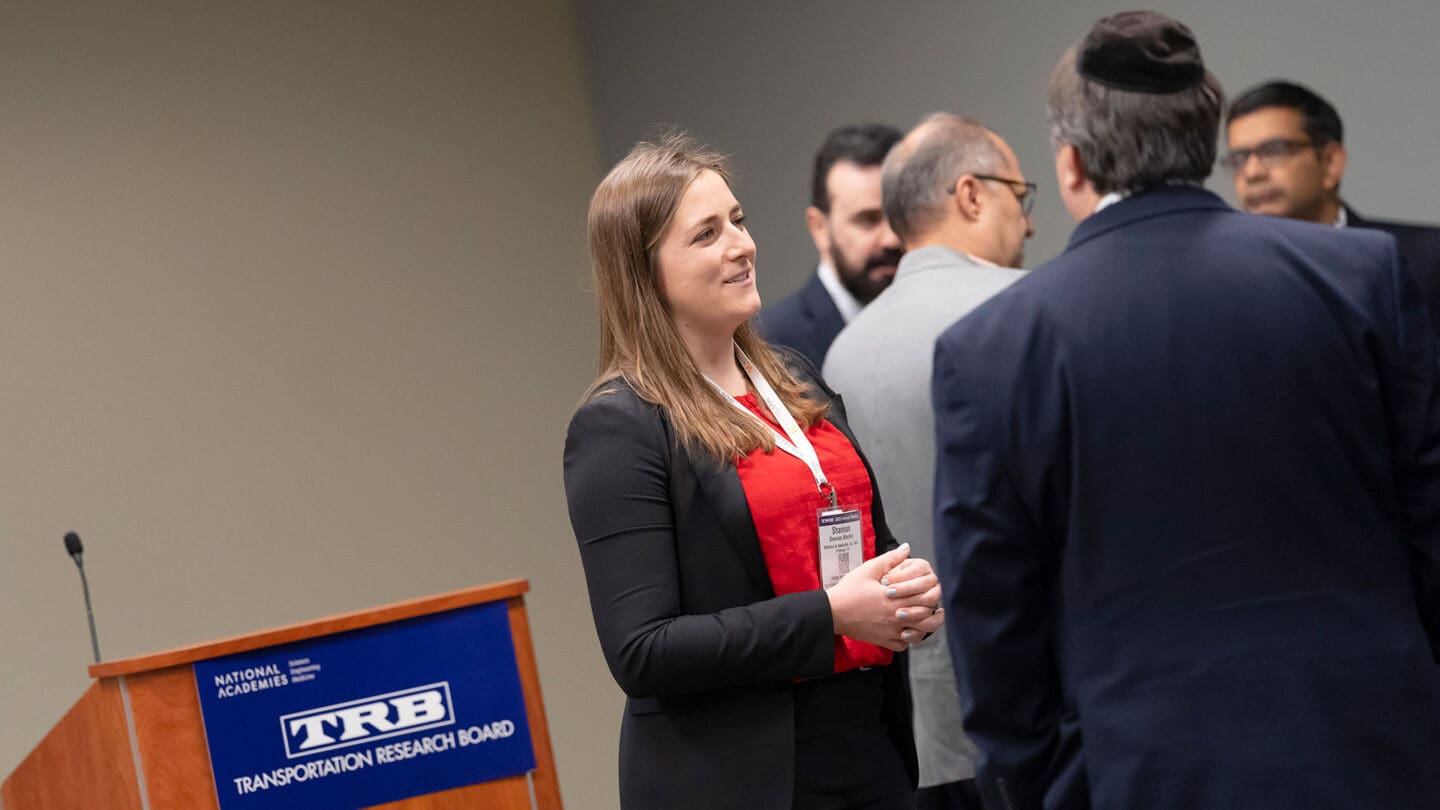
Shannon Warchol takes questions after a presentation at the 2023 TRB Annual Meeting.
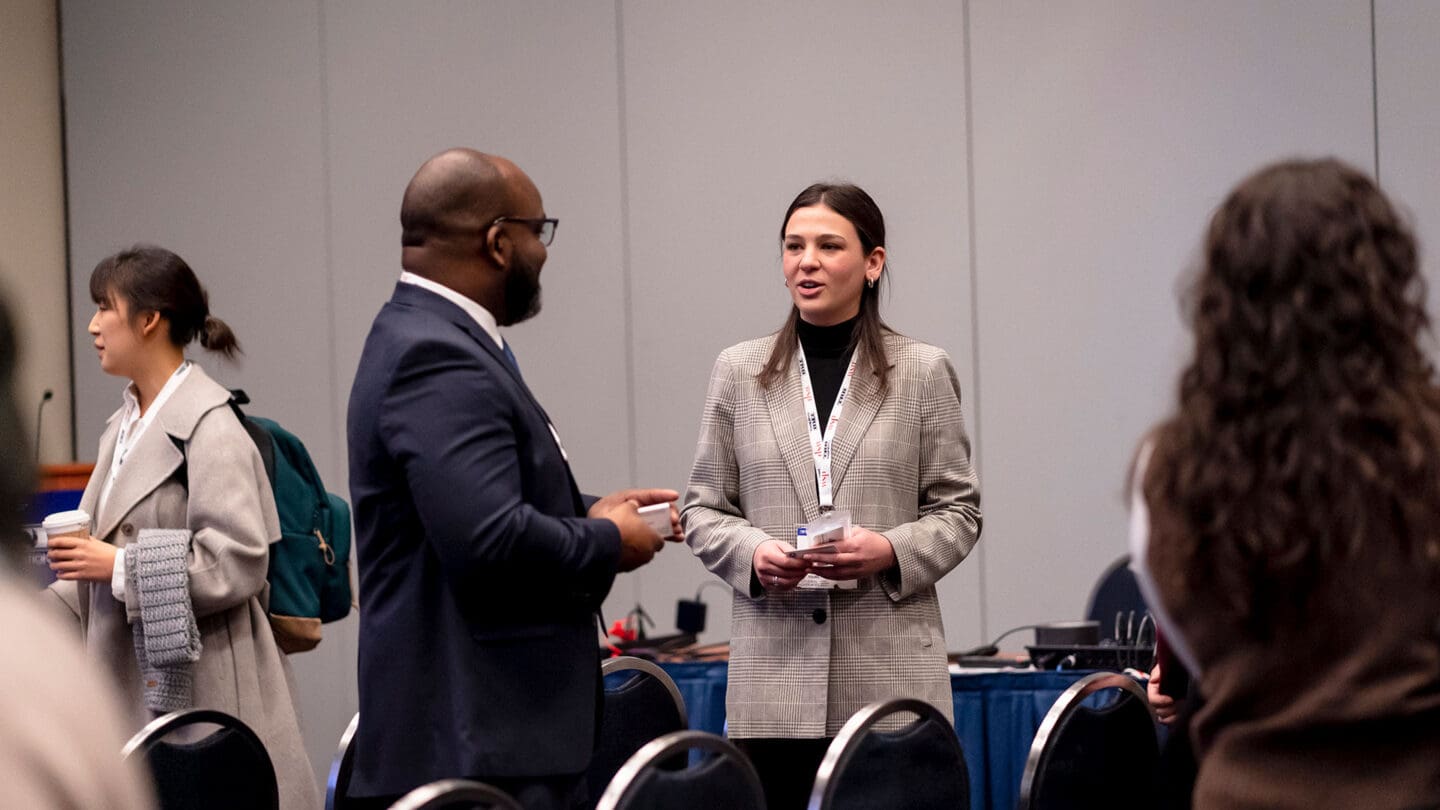
Peyton Ratto discusses her presentation on affordable housing development at the 2024 TRB Annual Meeting.
So, You Want to Join a TRB Committee?
Attending TRB’s annual meeting can be overwhelming even for seasoned pros—attempting to get involved in committee work can introduce an additional level of intimidation. For the interested but intimidated, here are some tips for getting started on a committee:
- Quality, not quantity: instead of trying to hit as many TRB sessions as possible, focus on attending sessions or committees that most appeal to your interests, skills, or aspirations.
- Find a buddy (and make yourself known!): Breaking into any group alone can be scary; finding a “host” within a group can make you an insider right away. Forming a single committee connection can quickly proliferate new ones. Only with a solid foundation of connections will you get a sense of how you could contribute to a committee.
- Keep showing up: Rome wasn’t built in a day, after all. If you feel like your debut on a TRB committee is muted, don’t take it as a sign of irrevocable failure; it may take several meetings to establish yourself as a contributing presence in a committee. Consistency is key.
Here at Kittelson, we’re proud of our team members who have taken the initiative to find their niche within TRB and participate in these industry-leading conversations. Many more members of the Kittelson team are actively involved in TRB committees, and already working hard to make the most of the 2025 Annual Meeting. Get in touch with Hermanus, Pete, or Nick to hear more about their experiences on TRB committees, and check out a full list of standing committees here.
